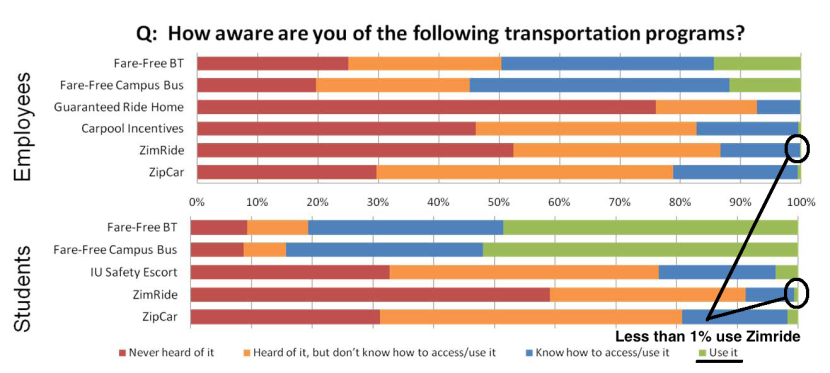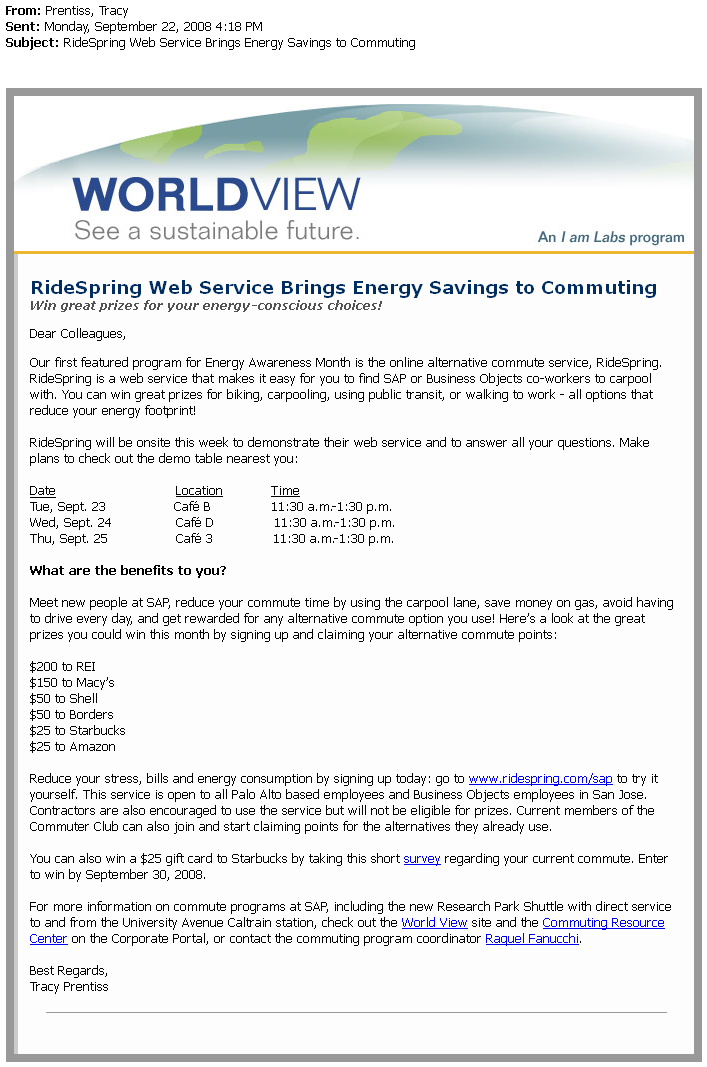Tagged: sustainability
Zimride case study at Indiana University Bloomington
Less than 10% know how to access/use Zimride
Less than 1% actually use Zimride
From: Transportation Demand Management Plan. Indiana University Bloomington. Nov 2012. Page 51.
Download plan here: ZimrideIndiana-IUB-TDMReportNov2012 – Final
SAP achieved success with employer-focused cloud-based carpooling in 2008 – but it wasn’t TwoGo
On April 28th SAP announced TwoGo, a cloud-based service that enables carpool matching between employees at client companies. The purpose of this new service is to enable employers to reduce:
- Commute trips (directly addressing the peak traffic congestion problem)
- Energy consumption
- CO2, pollution
- Parking demand
- Employee commute time (by using carpool lanes)
- Employee commute costs
- Employee commute driving (by being a passenger on some commute days)
… as well as increasing employee communication, camaraderie and collaboration between coworkers as they carpool together.
Check out the GreenMonk blog by Tom Raftery: SAP TwoGo – ride-sharing software for the enterprise. Some highlights:
In a less than obvious move earlier this week, SAP launched a ride-sharing app called TwoGo. Why less than obvious? Well, ride-sharing is generally perceived as more of a consumer focused activity, than an enterprise one. A quick search for ride-share iPhone apps, for example returns 24 results, all of which are consumer software plays.
Given all the benefits of TwoGo, we have to wonder why other enterprise software vendors haven’t come up with a similar product before now. Or have they? Does TwoGo have an enterprise competitor we’re not aware of?
Answer: Yes – RideSpring. In fact, SAP was a RideSpring customer from 2008 through 2012. SAP RideSpring email launch announcement from September 2008:
Thank you Tracy Prentiss, VP Business Development, who was the champion bringing RideSpring on board at SAP. It was a pleasure working with Tracy and her team creating one of the most successful sustainability initiatives at SAP Labs in Palo Alto. Check out the SAP/RideSpring case study featured in CBS SmartPlanet in 2010:
Cracking the carpool conundrum
http://www.smartplanet.com/video/cracking-the-carpool-conundrum/406777
Produced by Jason Pepper, CBS Interactive.
Brief history of TwoGo
According to SAP, “The idea started in 2008”- the same year RideSpring was delivering success at SAP. After several years in development, TwoGo was launched internally at SAP in 2011, and TwoGo is now is being released as a commercial service to be sold to employers.
Looking forward to sharing more in future posts!
Estimated results for Cabrillo College with RideSpring
What could Cabrillo College have achieved with the RideSpring program if they had been funded?
If the Air District had funded Cabrillo College’s top priority for CO2 reduction in 2008 I am confident they would have created the biggest success story of any RideSpring client. The larger the organization (number of employees/commuters) the more powerful the results generated. Our largest client so far has been 6,500 employees. Cabrillo College is much large with approximately 17,000 commuters.
Why would we expect larger populations to generate more powerful results?
One of the biggest advantages of a prize program is that with the same value of prize incentives, the larger the organization, the more people participate which drives higher cost-effectiveness. This intuitively makes sense: imagine a $500 prize program promoted at a company with 1000 employees. You would expect higher employee participation than at a company with 500 employees.
This is exactly what we have seen with RideSpring clients. Below shows the level of participation at companies with 600, 2400, and 6000 employees, all with $500 worth of prizes offered per month:
| Employer A | Employer B. (County of Santa Cruz) | Employer C | Cabrillo College | |
| Number of employees | 600 | 2400 | 6000 | 17000 |
| Value prizes per month | $500 | $500 | $500 | $500 |
| Number of employees participating per month | 130 | 228 | 508 | ? |
| Incentive cost per active per month | $3.85 | $2.19 | $0.98 | ? |
What these figures mean:
- At Employer A it costs $3.85 per month incentive for each participating employee to use an alternative commute and report their commute trips each month
- At Employer B the incentive cost is $2.19 per month
- At Employer C the incentive cost is $0.98 per month
From these three case studies (and seven others not shown) we have developed a reasonably accurate model that allow us to estimate the level of participation, for any sized organization, for any level of prize incentives. From this model, the estimated results for Cabrillo College would be:
775 active participants per month for an incentive cost of $500/775 = $0.65 per participant per month
Completing the above table:
| Employer A | Employer B. (County of Santa Cruz) | Employer C | Cabrillo College (estimated) | |
| Number of employees | 600 | 2400 | 6000 | 17000 |
| Value prizes per month | $500 | $500 | $500 | $500 |
| Number of employees participating per month | 130 | 228 | 508 | 775 |
| Incentive cost per active per month | $3.85 | $2.19 | $0.98 | $0.65 |
How do these costs compare with conventional commute incentive programs? Instead of earning chances to win prizes, conventional programs reward participating employees with a predictable financial benefit, such as $2 for every day they bike, carpool, or use transit to work. Locally in Santa Cruz this type of conventional program is used at least two organizations: Santa Cruz County Regional Transportation Commission reward their employees $2 each day they use an alternative commute (bike, carpool, transit… any alternative to driving solo). At Ecology Action their employees are rewarded with $4 per day. Some large corporations also offer this type of direct financial benefit: Genentech and Google, for example. See here: http://www.gene.com/careers/benefits/commuting
However, cash incentives are relatively ineffective at changing commute behavior. Thanks to Steve Raney, smart mobility consultant, who has extensively researched this area. One of his conclusions:
“This “carrot” [$4 per day] is not a sufficiently large motivator to cause commuting behavior to change”
Read more of Steve Raney’s research here: http://www.cities21.org/TRB_Paid_Parking.pdf
It gets worse – even though $4 a day is perceived as a small incentive that does not motivate – if it did work, cashout programs such as this would be too expensive for many organizations. $4 a day can be 20x times more expensive than prize incentives for generating the same results. Looking again at Employer B from above: County of Santa Cruz. The table shows 29,764 alternative commute days reported over the 12-month period. The total prize cost for the year is $6,000, and the cost for a $4 a day program would have been $119,056 if the same results had been achieved. This cost would have been financially unworkable.
| Employer B. (County of Santa Cruz) | |
| Number of employees | 2400 |
| Value prizes per month | $500 |
| Number of employees participating per month | 228 |
| Incentive cost per active per month | $2.19 |
| Last 12 month of service | |
| Total cost of prize incentives | $6,000 |
| Total AC days reported | 29,764 |
| $prize cost per AC day reported | $0.20 |
| Total cost at $4 per AC day reported | $119,056 |
| Cost savings with prize program | $113,056 |
| 95% |
Note that the cost advantages for large organizations with prize incentives do not exist with conventional commute incentive programs. A company with 1,000 employees is likely to see twice as many employees participating as a company with 500 employees (same % of employees participating) with a $4 a day program, but the incentive cost would exactly double as well – with no improvement in cost effectiveness.
Finally, we can now compare the expected results at Cabrillo With the SCCRTC program that the Air District funded instead of the RideSpring program at Cabrillo College:
Would love to hear your feedback/questions/comments about this! Leave a comment…



